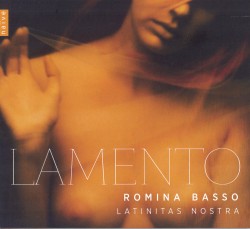 Lamento (Kapsperger; Rossi; Carissimi; Strozzi; Frescobaldi; Monteverdi; Provenzale)
Lamento (Kapsperger; Rossi; Carissimi; Strozzi; Frescobaldi; Monteverdi; Provenzale)
Romina Basso; Latinitas Nostra
naïve V5390
Monteverdi’s Lamento d’Arianna pioneered the art form known as the lamento, where the death of a famous figure was commemorated by a solo singer accompanied by basso continuo. In addition, techniques such as dissonant chords and melodies with wide leaps would add their own sense of lamentation.
Latinitas Nostra is a Greek ensemble; their west-looking title refers to the flourishing Greek communities in places such as London and Venice. Soprano Romina Basso begins with Luigi Rossi’s lament by the Queen of Sweden for her husband Gustavus II Adolphus, the brilliant commander killed at Lützen in 1632. The lament combines the Queen’s sense of desperation with an exhortation to kill and strike the Germans, Spaniards and Italians without mercy. Romina Basso rises to this varied emotional challenge with passion, whether one considers this to be a true lament or a plea to crush Sweden’s enemies.
Mary Queen of Scots is the next subject of lament, in this case by Carissimi. Here the tone is again a mix of lamentation and anger: Mary protests her death sentence and expresses resentment against the English regime that created this situation. Vibrato effects enhance the sense of anger. Basso and her continuo admirably meet the demands of the lament.
Then, one of the most accomplished lady composers of all time, Barbara Strozzi. Lagrime mie lingers over its text and uses pauses to reinforce the emotion. Strozzi’s interpretation makes full use of what one might call surges of melody to reinforce the intended effects of the lament.
And then to Monteverdi with Lamento d’Arianne in its five parts. If ever there was a fine basso continuo accompanying a lamento this was it. All the instruments involved make their presence felt, sometimes supporting and enhancing the plaintive singing, sometimes almost mocking it.
Finally, and to be frank, out of place, is Francesco Provenzale’s “lament” for Gustavus II Adolphus. This is less respectful in its lyrics, almost poking fun at his queen as she learns of his fate. There are exchanges of dialogue which, from the English translation, contain double entendres and undignified comments. In fact, this is not a solo lament; it is accompanied by other voices and the sleeve notes inform us that musicologists have not quite worked out why it was composed. It may just have coincided with Gustavus’ daughter Christina’s spectacular conversion to Catholicism in 1655.
This CD is a fine introduction to a musical form both delicate and forceful.



